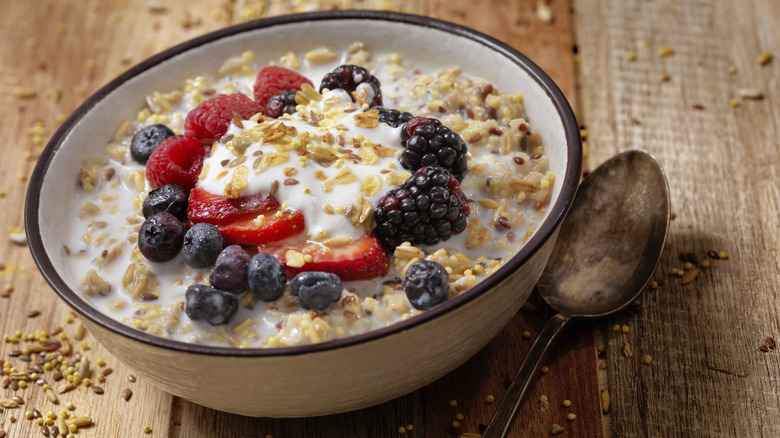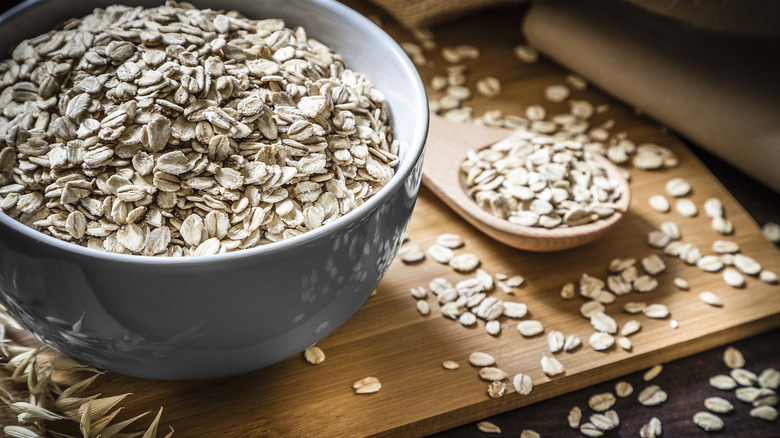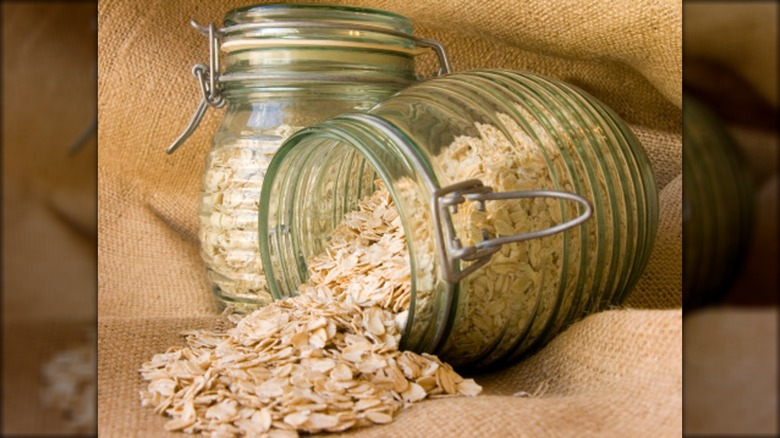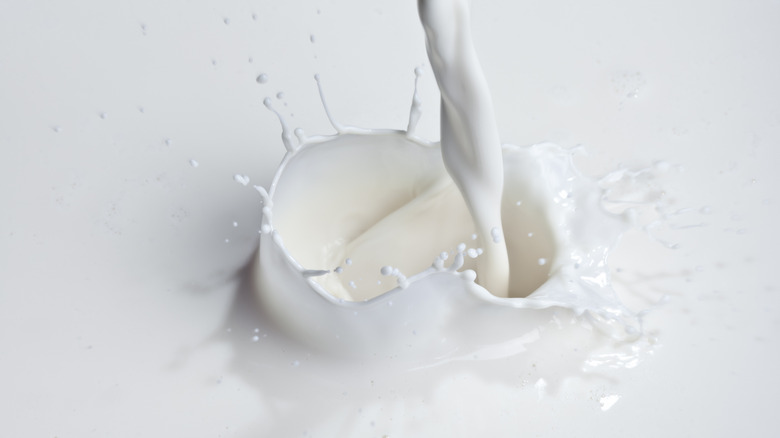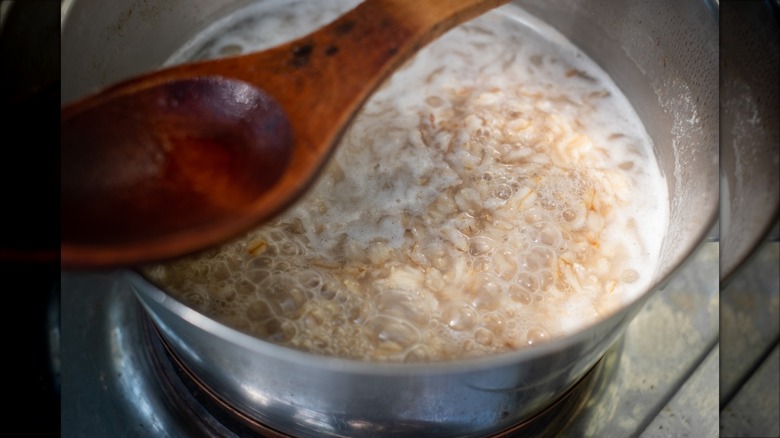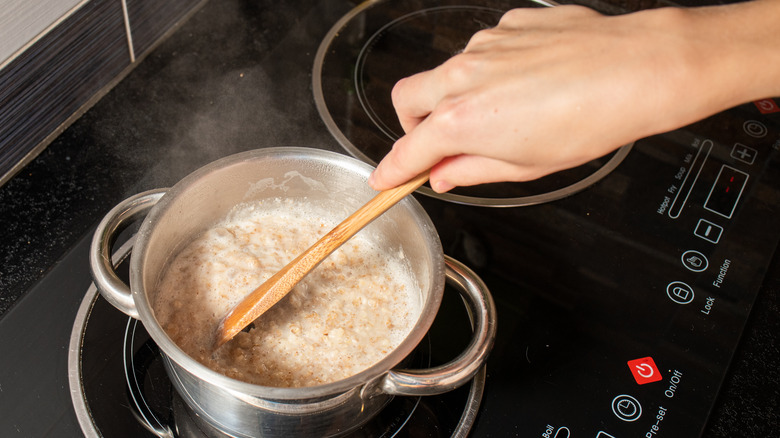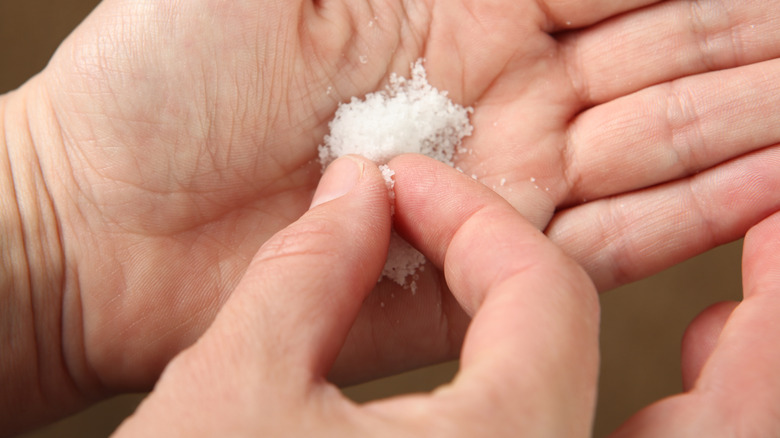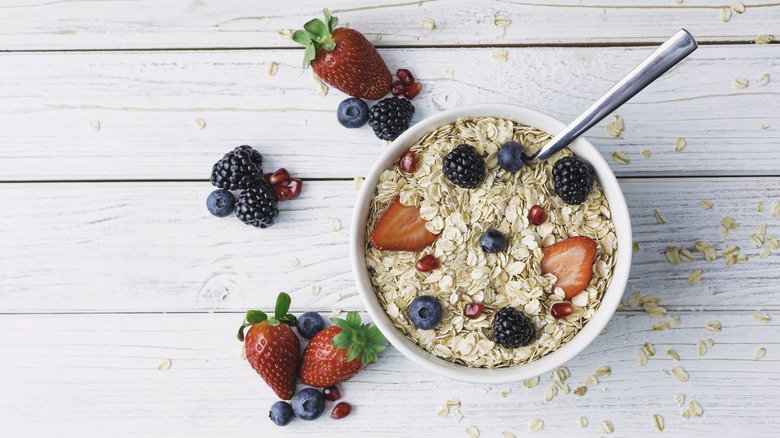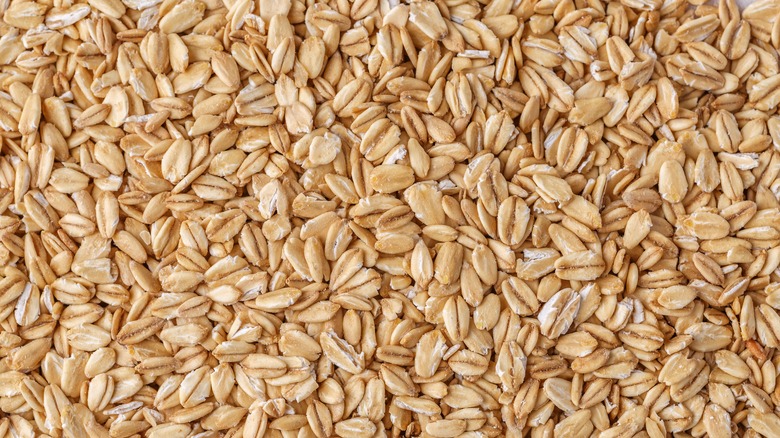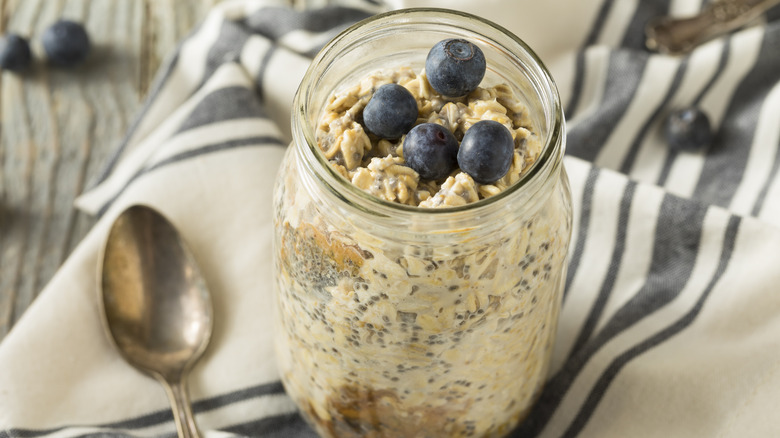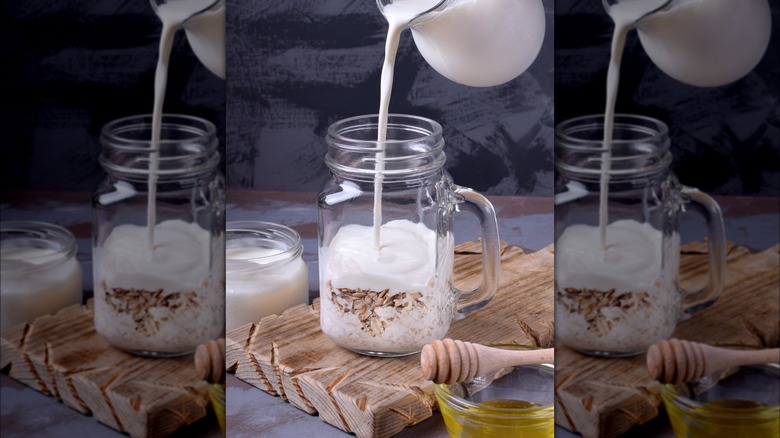10 Tips You Need To Know When Cooking Oatmeal
Oatmeal can provide you with a delicious and nutritious start to the day. According to The American Heart Association, oatmeal has several qualities which make it a heart-healthy food. For one, it has been shown to help lower cholesterol and aid with weight control. Moreover, that same bowl of morning oats also delivers vitamin B1, manganese, and other essential vitamins and nutrients to support immunity, blood clotting, metabolism, and more. Even more, oatmeal is high in soluble fiber, helping you stay full for longer periods of time.
On top of all of these health benefits, oatmeal can be delicious. However, it can also turn out slimy or gummy if it isn't prepared right. If you want to know how to make sure that your oatmeal turns out properly and delivers the maximum health benefits, then keep reading. The tips shared below will guide you towards making that perfect bowl of oatmeal a reality.
Understand that there are differences between quick oats, rolled oats, and steel-cut oats
One of the most important things you need to know before starting to prepare oatmeal is that there are different types of oats. These include steel-cut oats, rolled oats, and quick oats. All three types of oats begin as oat kernels with their shells removed (oat groats). The way in which these oat groats are processed differs for the various types of oats.
Steel-cut oats go through the least amount of processing. This means that they are on the chewier side and have more of a nutty flavor. The cook time for steel-cut oats will also be the longest, typically ranging from 15 to 30 minutes. For rolled oats, also called old-fashioned oats, the oat groats are steamed and flattened. This gives them a more subtle flavor and a softer texture than steel-cut oats. They also only take a few minutes to cook. Quick oats — also called instant oats — undergo the most processing of the three varieties. The processing of these oats involves pre-cooking them and rolling them so that they are very thin. This allows them to cook much more quickly and leaves them with a softer texture and an even milder flavor.
When possible, opt for steel-cut or rolled oats over instant options
When given a choice between the three different types of oats, choose either steel-cut or rolled oats. Both of these types of oats will allow you to maximize the health benefits of eating oatmeal. Because of the extra processing it goes through, instant oatmeal has a higher glycemic index, according to The American Heart Association. This means that it can cause your blood sugar to increase more quickly than the other oat varieties.
Trying to stay away from flavored instant oatmeal packets is another way you can make sure you're enjoying a truly healthy breakfast. While the flavor packets may start with oats derived from the same source, they are highly processed to ensure that they'll cook quickly. Moreover, as the Cleveland Clinic notes, these instant flavored packets can contain a lot of sugar. Some brands may have up to 17 grams of added sugar.
Use milk instead of water to make the oatmeal creamier and more filling
The directions on many packages of oatmeal say to cook the oats in water. While you certainly could follow these directions, you might want to try cooking your oatmeal in milk instead the next time you're making it. Using milk can yield a creamier finished product. Plus, because of the protein the milk adds to the meal, each bowl will be even more filling and satisfying.
There are a few tips to keep in mind if you want to cook your oats in milk because the best way to do so will vary depending on the type of oats you're using. For quick oats, you can simply replace the water with milk and cook according to the package directions. However, for rolled oats and steel-cut oats, you'll need to add in a few extra steps to help soften the oats and prevent them from turning out too chewy. With rolled oats, start by bringing ½ cup of water to a boil for each ½ cup of oats you're preparing. Allow the oats to cook in the boiling water for about 2 minutes. This will give them some time to soften up by soaking up the water. Then, you can add 1 cup of milk (for each ½ cup of oats) and bring the oats and milk to a boil before letting everything simmer until cooked (about 4 minutes).
If you're preparing steel-cut oats, you'll need to add the extra steps of rinsing the oats a few times and then letting them soak in some water overnight. When you're ready to cook the oats, drain the water and put them in a pot with ½ cup boiling water (for each ½ cup of oats). Let them cook for a few minutes to further soften up, then pour in 1 cup milk, bring to a boil, and simmer until ready.
Take care to add the right ratio of oats and liquid
Whether you're cooking quick oats, rolled oats, or steel-cut oats, adding too much water or milk will adversely affect how your oatmeal turns out. You don't want to add too little liquid and end up with a hard and crunchy oatmeal, but you also don't want to add so much that you have a soupy mess. To avoid this, you need to learn the proper ratio of water to oats — and understand that it will vary across different types of oats.
When you're preparing rolled oats or quick oats, you'll need about twice as much water or milk as oats (2 parts water/milk to 1 part oats). For example, if you're making one serving of oatmeal (½ cup oats), you should start with 1 cup of water or milk. Steel-cut oats require more liquid to sufficiently soften their coarser texture. You'll need between three and four times as much water as oats (3 or 4 parts water/milk to 1 part oats). For a ¼ cup serving, that means that you should bring between ¾ cup and 1 cup water or milk to a boil in your pan.
Know when to add the oats to the milk or water and where to set the burner temperature
To ensure your oatmeal turns out right, you need to know when to add the oats to the milk or water and where you should be setting the burner temperature. Without this knowledge, you could end up with a sticky or burnt-on mess. Let's start with when to add the oats to the liquid. In most cases, the best time to pour in your oats will be after your milk or water reaches a rolling boil. This will yield a textured oatmeal with just a hint of crunch. The other option is to put the oats in the water or milk before you bring it to a boil. This might be something you want to try if you prefer a creamier and softer oatmeal.
Either way, once your water has started to boil, you must turn the burner down. Adjust the dial to about medium-low heat while the oats finish cooking (for some stovetops, you might find that low heat works best). Leaving the burner set too high will cause the oats to stick and burn on the bottom of the pan, something you certainly don't want.
Don't forget a pinch of salt
If you're trying to be healthy, you might think that skipping adding salt to your oatmeal as it cooks is a good idea. Similarly, you could think that salt isn't really necessary, especially if you don't enjoy salty foods. However, skipping the salt is not advised when making oatmeal, at least not if you want it to taste as good as possible.
Salt is a flavor enhancer. Adding it to your oatmeal will give it a hint of nuttiness and an overall more enjoyable flavor. If you are trying to watch your sodium intake, rest assured that it doesn't take much salt to deliver these benefits. Just a pinch should do the trick. And be sure to add it to the water or milk before you pour in the oats, not after they've finished cooking. If you wait to add the salt until after the oatmeal has finished cooking, it will end up giving it an unpleasant, salty taste.
Add mix-ins to up the flavor and nutrition of the oatmeal
One of the best ways to upgrade the flavor of your oatmeal is by adding mix-ins. While a plain bowl of oatmeal may be OK on occasion, it is going to grow old and boring really quick if you don't change things up with some exciting mix-ins. Fortunately, there are so many different toppings and mix-ins that you can add to your morning (or even afternoon) bowl of oatmeal that will keep things new and exciting while also helping to boost the nutritional content of the meal.
Fruit is one of the most popular toppings for a bowl of oatmeal. You can try just about any fruit that you like, including berries, sliced apples or peaches, bananas, or mango. Nuts and seeds can also make excellent toppings for oatmeal. They'll add some crunch and texture to each bite for an experience that will stimulate your taste buds. A few other mix-in ideas include dried fruit, shredded coconut, chocolate chips, peanut butter, protein powder, and even veggies such as carrots or squash.
Try toasting the oats before cooking
Adding one small step into your prep time when making oatmeal can have a big impact on the way the finished product tastes. Instead of scooping or pouring the oats from their bag or canister directly into the pot of water or milk, try toasting them first. When you toast the oats before preparing the oatmeal, it will help give the finished product a richer flavor. It will taste as if there is a hint of caramel mixed in, but in reality, you won't actually need to add any other ingredients.
And, even better, toasting oats is a very simple task that won't take too much of your time. All you'll need is a frying pan and the oats. Start by heating up the frying pan over medium-high. Then, measure out the quantity of oats that you plan to cook and pour them into the hot pan. Use a spatula to stir the oats frequently to prevent them from sticking or burning, and remove them from the skillet once they have a fragrant aroma and a light-brown color. Once toasted, cook the oats as normal.
Try overnight oats instead of cooking on the stovetop to speed things along at breakfast time.
Even though making a pot of oatmeal doesn't take that long, it can still feel like too much time to wait on an already crazy morning before work or school. One way you can streamline things for those busier mornings is by trying overnight oats. As their name suggests, overnight oats are 'cooked' overnight. With this method, you actually don't need to bring milk or water to a boil and cook the oats in the hot pan. Instead, you simply add the oats to the liquid the night before.
Overnight, they'll absorb the liquid and soften up. The process also yields an even creamier bowl of oatmeal for you to enjoy. This is because of the fact that no heat is used when preparing the oats, so their molecular structure is different. Saving yourself the hassle of making breakfast the following morning will only take a few minutes of your time. Simply add the milk, oats, and any mix-ins (such as honey, poppy seeds, cocoa powder, or peanut butter) into a mixing bowl. Stir them together and transfer the mixture into jars to create individual portions. Let the flavors meld while the oats soak up the mixture in the refrigerator overnight, and enjoy the deliciousness the next morning.
If you are making overnight oats, use rolled oats for best results
While overnight oats can help you get the day off to a great start, there is one other important detail you'll want to pay attention to before whipping up a batch of them. Rolled oats, or old-fashioned oats, are the best type of oats to use when preparing them. When you start with rolled oats, your overnight oats will have the ideal texture and consistency. Because rolled oats are flattened and elongated during production, when they are soaked in liquid overnight, they'll still have a slight crunch but won't turn into complete mush.
If you remember, steel-cut oats are not as processed. If they are used for overnight oats, the resulting oatmeal will be too tough and crunchy. Instant oats, on the other hand, are pre-cooked during production. Because of this, they'll end up too soft, giving the oatmeal an off-putting texture for many people.
